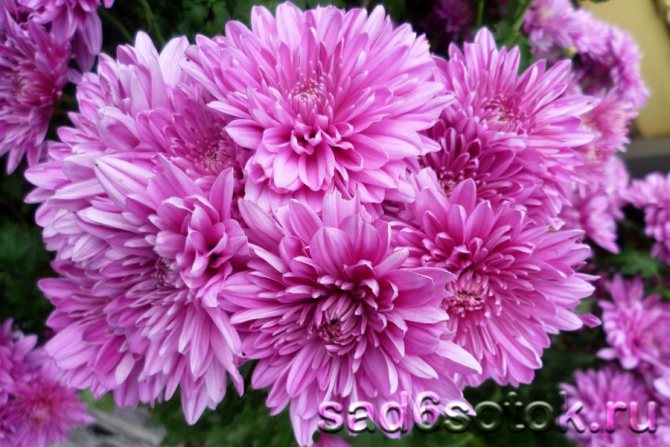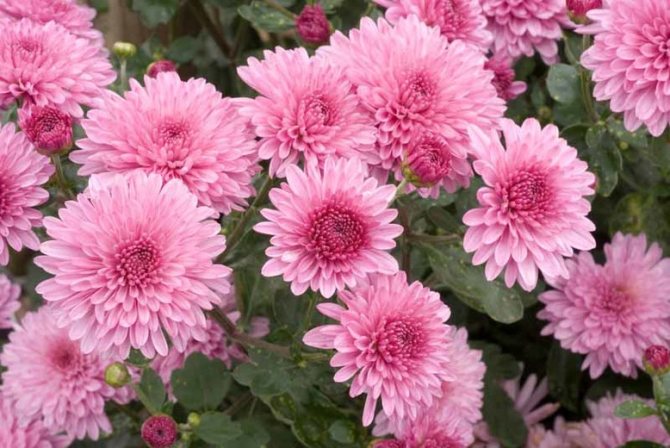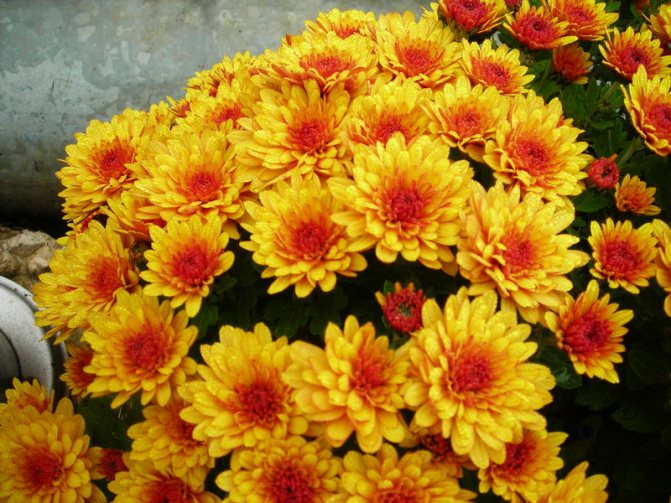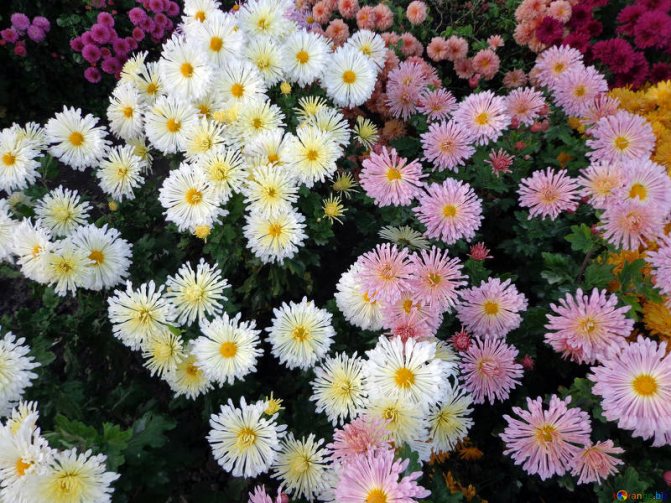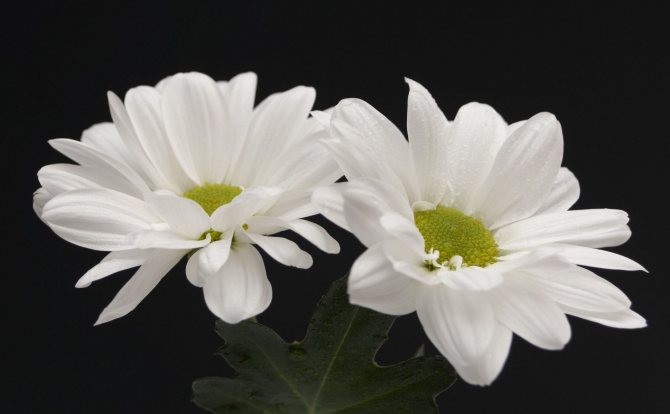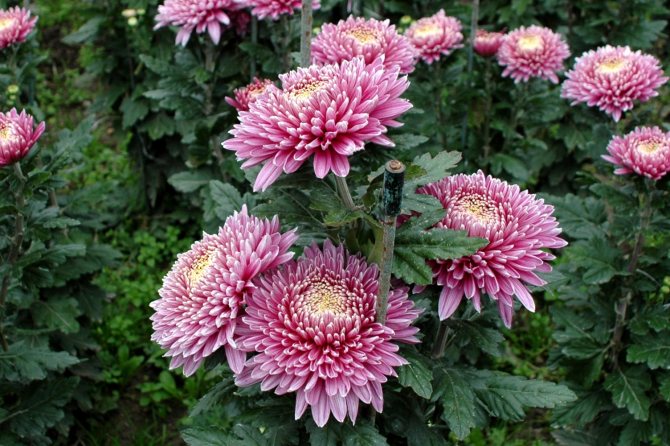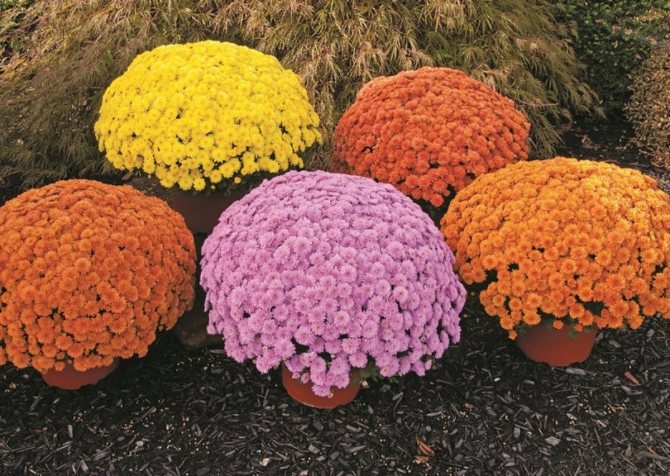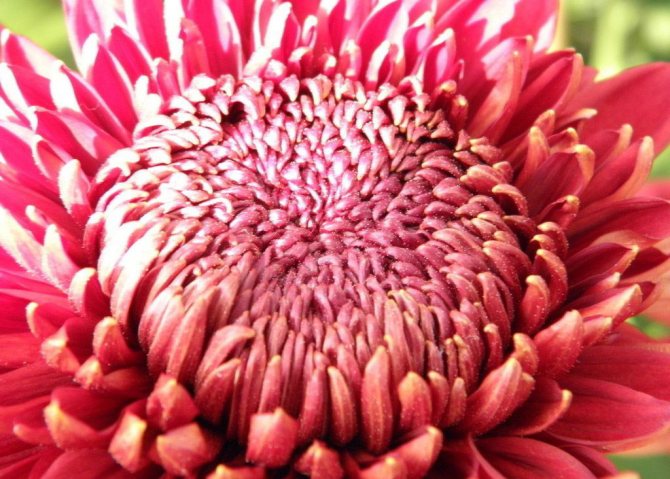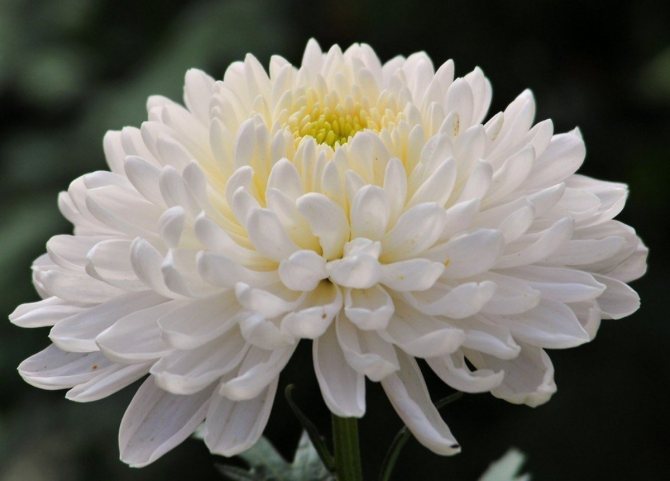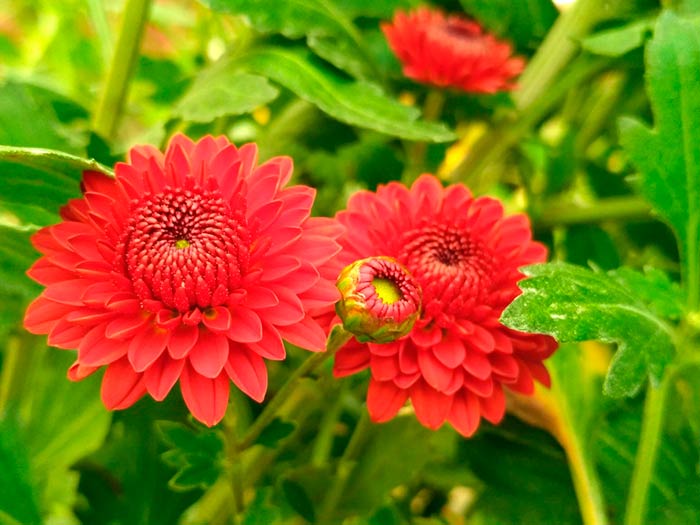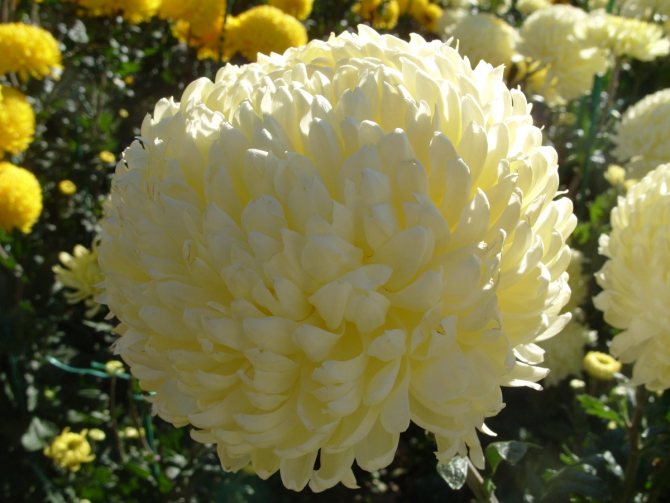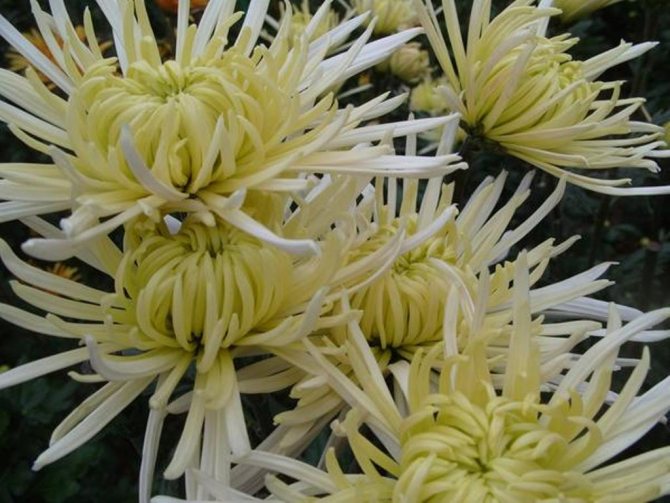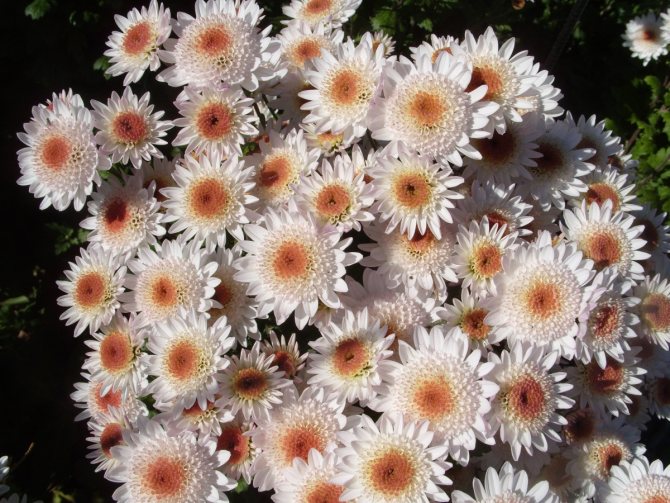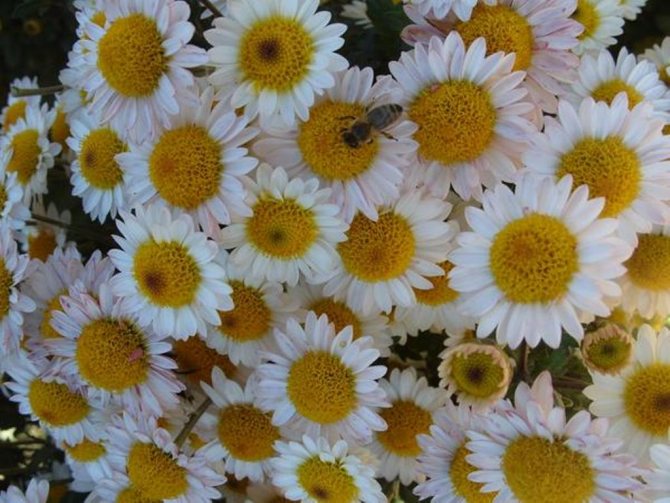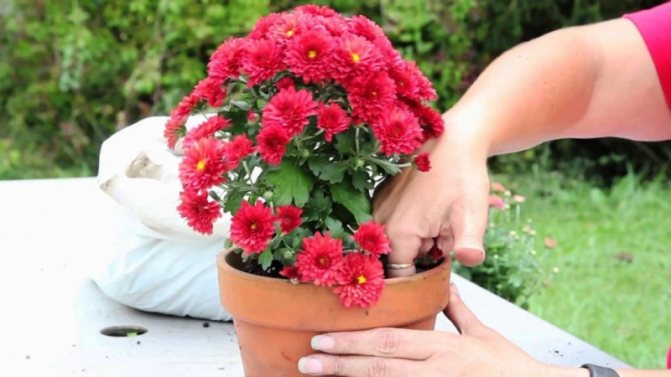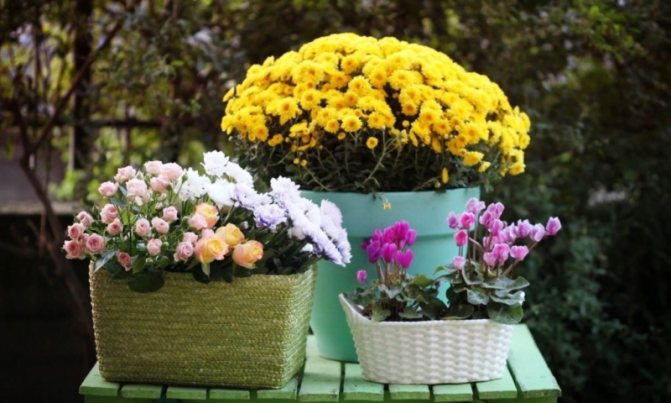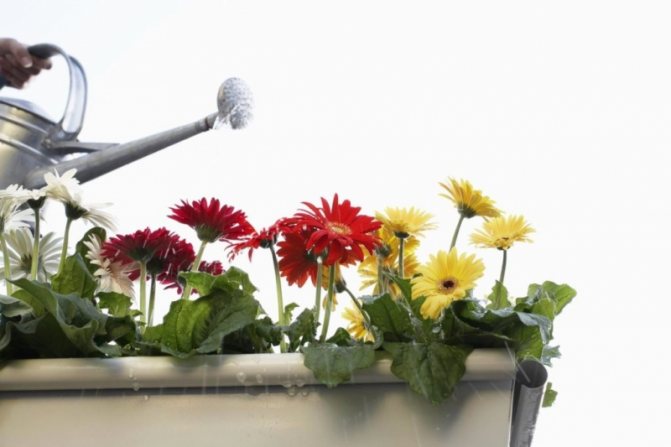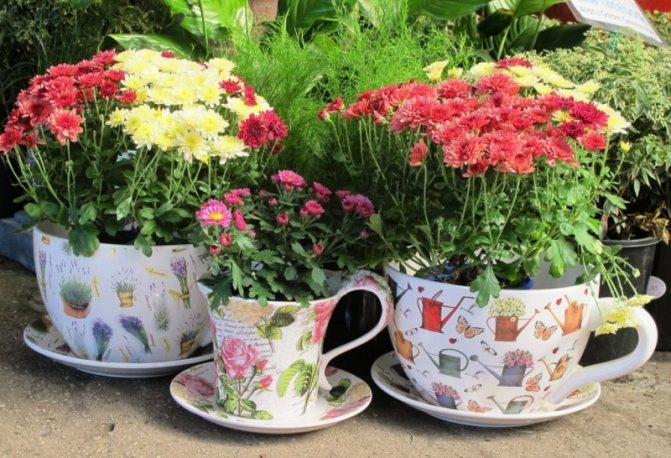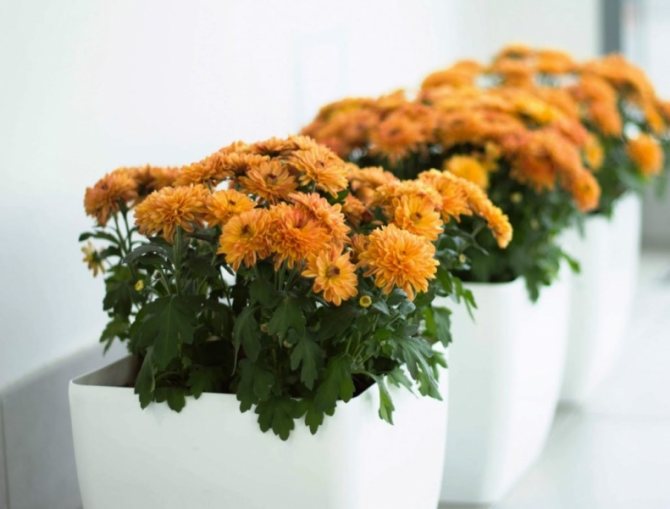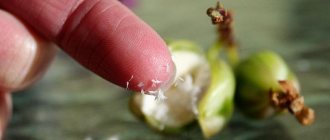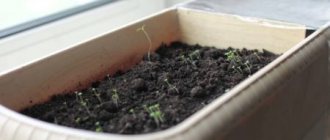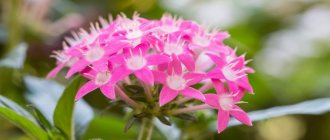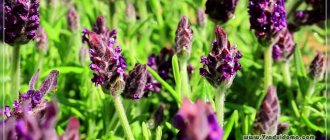If you plant chrysanthemums of different flowering periods in a flower garden, you can enjoy their flowering from August until the first snow.
You can pick up small-flowered border varieties no more than 30 cm in height or one and a half meter plants with large flowers. And the variety of forms of inflorescences is truly impressive - bristly, pompom, anemic, curly, flat, spherical and spider-like.
Perennial chrysanthemums have a greater variety of varieties than annuals.
Summer residents often either divide the mother bush or use cuttings to propagate perennial varieties of chrysanthemums. The seed propagation method is less common.
However, when I decided to grow these flowers in my summer cottage for the first time, I used it. This process turned out to be not as difficult as it seemed at the beginning.
It was possible to sow seeds directly into the ground in a permanent place. But I would not be able to provide the young seedlings with proper care, since I visit the dacha only on weekends. Therefore, I decided to grow flowers through seedlings. Moreover, the seedling method allows you to achieve the beginning of flowering much earlier.
The seeds of perennial chrysanthemums must be sown for seedlings in mid-to-late February, as young seedlings develop very slowly. At a later sowing date, you can not wait for flowering in the first year.
For planting, I used a cake container and purchased flower soil mixture. For this purpose, you can take garden soil mixed with humus and peat in equal proportions.
In the bottom of the box, I made several holes with an awl to drain excess liquid. Then she laid small stones on the bottom of the container as drainage and filled it with soil by 2/3 of its volume.
She spilled the soil with warm water, and simply scattered the seeds on top and lightly pressed her palm to the ground. It is not worth covering them with soil from above, but you just need to moisten them a little from a spray bottle. The box was covered with cling film and left in a warm place.
Until the emergence of shoots, she periodically aired the seeds and made sure that the soil remained moist all the time. The sprouts appeared in ten days. I immediately moved the container with the seedlings to the lightest windowsill, but did not immediately remove the film. In the first days, I took it off several times a day for an hour or two, then gradually increased the airing time, and then removed it completely.
Since at first the sprouts looked very weak, the soil was moistened only from the sprayer.
In the morning and in the evening, she always turned on the lamp for additional lighting. And the temperature in the room was maintained at 15-18 ° C.
Top dressing began to be carried out 10 ten days after the emergence of shoots with a regularity of two weeks. After the appearance of 3-4 real leaves, carefully using a fork, I cut the delicate plants into separate cups.
After picking, the soil in the cups spilled and sprayed the sprouts with Epin's solution. I want to note that you should not be zealous with watering chrysanthemum seedlings.
The soil should be constantly moderately moistened. But you should not allow the soil to dry out either.
After establishing warm sunny weather outside the window, I transferred the seedlings to the balcony.
After the threat of frost was over, I transported her to the dacha. I did the transplant in the evening. I chose a sunny and quiet place for landing.
She planted seedlings not in holes, but in a trench at a distance of 30-40 cm from each other. I dug up the earth in this place, added humus and a little ash.
After transplanting, I first watered the shoots with plain water, and then sprayed it with Kornevin's solution on wet ground so that the rooting process in a new place was less painful.
Since she planted a variety of low bush chrysanthemums, immediately after planting, she pinched a growing point for each seedling. Later, when lateral shoots developed on them, I carried out a pinching on them. Thanks to this technique, I subsequently formed dense fluffy bushes of chrysanthemums.
It is not necessary to pinch the varieties of tall chrysanthemums with large flowers; their lateral shoots should be removed altogether, leaving only a few of the strongest ones.
In order to fully appreciate the beauty of the flowering of these plants, they must be watered regularly throughout the season.
With a lack of moisture, the bushes will develop weak, and flowering will be poor. Moreover, chrysanthemums need to be watered only at the root.
You also need to loosen the soil and remove weeds.
And feeding should be mandatory, but not excessive. I alternated feeding with organic and mineral fertilizers every two to three weeks. At the beginning of growth, attention should be paid to nitrogen fertilizing, and during the budding period - to phosphorus-potassium.
It is not difficult to care for chrysanthemums, these plants are quite unpretentious.
If you follow these simple rules for caring for this decorative crop, it will surely thank you with lush and long flowering.
Planting material
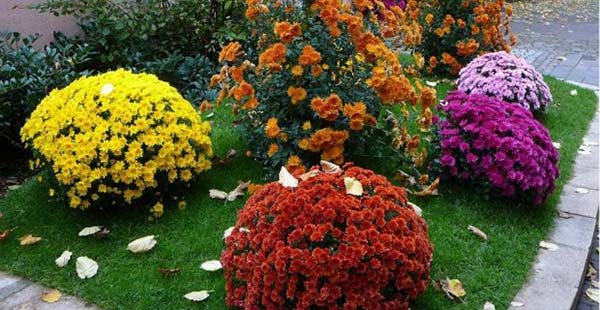
You can grow chrysanthemums in your garden using flower seeds, seedlings, or using cuttings.
Seeds
We begin to work with the purchased seeds of the variety we like in early spring. When growing chrysanthemums from seeds directly into the ground, first water the prepared holes well, and then sow seeds in them. After sowing, it is necessary to provide the seeds with a favorable temperature regime. To keep the soil moist and not overcooled, it is covered with plastic wrap. In this form, the sowing site is left until sprouts appear.
Chrysanthemums sown from seeds are annuals. With spring sowing, flowering will begin in the first decade of August.
To accelerate the beginning of flowering, we use seedlings. Let's start by preparing the flower containers and moistening the soil in them. After sowing the seeds, they only lightly sprinkle them with earth and leave them under a film until germination. The sprouts will appear no later than a week. This method is most suitable for growing seedlings. When using seeds, it should be borne in mind that they do not have the ability to preserve the variety.
Saplings
Saplings - dived seedlings of chrysanthemums. Their preparation for planting in the ground takes time. Initially, cups with unpicked seedlings should be kept in cool rooms. The optimum temperature is no less than 16 ° C and no more than 18 ° C. The soil in the cups is watered as it dries, trying not to overmoisten. Chrysanthemum seedlings require a sufficient amount of light for normal growth. Therefore, in dimly lit rooms, additional lighting is organized.
Cuttings
You can get a suitable cutting only from the main (root) shoot of the flower. Having retreated from above a leaf with a bud of 3-4 mm, at least 6-7 cm of the plant is cut off for the cutting. The procedure can be carried out in the spring, after the air has warmed up over 21 ° C. However, on hot days (over 26 ° C), grafting is not recommended. A cutting of a chrysanthemum cut with a sharp knife is immersed in moist soil, sprinkled with sand, having previously been treated with a growth stimulant. The thickness of the sand layer is 2 cm. The angle of inclination of the cutting is from acute to straight (from 35 ° to 45 °).
Useful Tips
Chrysanthemum seedlings are grown according to the general rules. However, there are several features, so novice gardeners need to pay attention to the following practical recommendations:
- Picking can be avoided by immediately planting seeds in peat tablets.
- The sprouts need light, so they are placed on the south or east window. If necessary, illuminate with a phytolamp for up to 12-14 hours a day.
- If, during planting, a weak growth is found, it is immediately discarded.
- If the weather is warm outside, the transfer can be done a little ahead of schedule. The main criterion: the height of the shoots should be at least 20-25 cm.
- 2 weeks before transferring to the ground, the seedlings begin to harden at a temperature of 15-16 ° C.
Planting a garden chrysanthemum
Planting perennial garden chrysanthemums begins with choosing a place. This needs to be approached very carefully. Sun Blossom loves open, well-lit areas that are protected from drafts. Experienced growers know: so that the flowers do not become small, you need to choose a place where the plant will not be in the shade. The soil is less important to the plant. But it is necessary to ensure that the soil has good drainage and there is no stagnant water.
Planting hole preparation
The hole prepared for planting should have a depth of more than half a meter, a suitable depth of 60 cm. We fill the landing hole, observing the following order. We start with the drainage layer. Materials suitable for drainage are small pebbles, expanded clay, crushed stone. The next layer is compost or organic matter. We fill the hole with soil mixture.
Landing dates
Experts believe that the most optimal planting of chrysanthemums in the spring. The pick-up time depends on the weather on the particular day. In sunny weather, boarding is possible only early in the morning or in the evening after sunset. But it's best to plant chrysanthemums when it's cloudy or rainy. In the southern regions, perennial planting chrysanthemums can also be carried out in the fall. But it is not recommended to plant chrysanthemums here in the second half of September or later.
When planting in spring or autumn, the following rules should be observed:
- Make sure that the root is not buried.
- Use supports when planting tall chrysanthemums.
Topping
For normal development, a chrysanthemum seedling is pinched twice. The first time the procedure is carried out immediately after planting in the ground, while the point of growth of the flower is removed. After 21 days, pinching is performed a second time. Now you need to break off the top of the flower so as to grab 2-3 knots.
Spring work
With the onset of spring, it is imperative to remove the tops and branches. But sweeping the peat is not at all necessary. This is mulch and fertilizer, without which it will be difficult to wait for good flowering. After the root growth has appeared, it is removed with a secateurs. Cuttings 6-7 cm long are obtained. They need to be dipped in Kornevin's solution and planted on a bed with well-fertilized soil, on top of which there is a layer of sand (about 2 cm).
It is imperative to spray and water the cuttings daily. From above, you need to stretch the film and be sure to organize shading from bright, sun rays. Do not forget to ventilate, and after 2 weeks your plantings will give good roots.
Young plants are planted in a permanent place in May, when the threat of frost has passed. Remember to water and mulch the soil well. As soon as the height of your plants reaches 15 cm, the most painstaking work begins. To get a tall stem with a lush flower, it is imperative to pinch all the side shoots and buds, leaving one. Moreover, the choice is not always obvious, the central one may turn out to be underdeveloped or ugly, so you need to carefully monitor your plant.
Garden chrysanthemum care
Chrysanthemum is not a particularly demanding flower.However, compliance with certain standards of care will ensure not only normal growth, but also long-term flowering of the chrysanthemum.
Caring for garden chrysanthemums includes the following processes: watering, mulching, feeding.
Watering
The constant maintenance of light soil moisture is a prerequisite for growing garden chrysanthemums. The amount of water for irrigation depends on the region of planting. In hotter and drier places, watering should be more abundant. But excessive dampness can harm the flower. In the process of budding, watering is somewhat reduced, flowering also requires a decrease in watering.
Mulching
To rid the planting of chrysanthemums from weeds, as well as to prevent the occurrence of fungal diseases, the soil around the bush should be mulched. Coniferous materials such as needles or pine bark are best suited for mulch. Sawdust has also been shown to work well as a soil mulch.
Top dressing
Garden chrysanthemum responds well to systematic feeding. They should be carried out at least 2 times a month. Plants are fed with nitrogen fertilizers in spring, this allows the flower to grow well. During the flowering period, fertilizers with a predominance of phosphorus and potassium are used. Mineral fertilizers are applied as root irrigation. From time to time, the plant will also benefit from bone meal used for feeding.
Preparing for winter
Garden chrysanthemum bush will tolerate winter temperatures well if properly prepared for the cold season. Before frost, faded shrubs are cut off, leaving no more than 2-3 cm. After that, chrysanthemum bushes are covered with fallen leaves, pine needles or branches. Varieties that bloom late are dug out of the ground, transplanted into a pot. Thus, they hibernate as houseplants.
Protection against diseases and pests
Chrysanthemum susceptible to root diseases are helped by using Fitosporin during feeding (in accordance with the instructions). It is also recommended to treat chrysanthemum bushes after rain with special preparations against fungal diseases and viruses. Folk remedies (soap solution, garlic tincture) help to cope well if aphids or mites appear on the plant. And crushed eggshells or cooled wood ash, which are sprinkled on the soil around the plant, helps to fight snails or slugs.
Pests
Most often, large-flowered chrysanthemums are attacked by nematodes. These pests can be recognized by mosaic spots on the leaves, which darken over time. Unfortunately, it is almost impossible to remove these insects. And the affected plant will have to be destroyed. To prevent the appearance of parasites, spray the flowers with a solution of "Phosphamide" before planting and digging up in autumn. And treat the soil with formalin.
Often, aphids settle on the lower part of the leaves and buds of plants. The colony of these parasites sucks out the juices of the culture, which slows down its growth and reduces the duration of flowering. If there are few insects, then remove the leaves and petals on which they have settled. If there are a lot of pests, then treat the shrub with an insecticide such as Aktellik or Aktara.
Slugs and snails are no less dangerous for flowers. They devour the leaves, stems and buds of plants. To prevent their appearance, sprinkle crushed eggshells near the bushes. If snails and slugs have already appeared, then they will have to be removed by hand.
Attractive large-flowered chrysanthemums will decorate the flower bed and fit into any landscape. Of course, in order to grow these crops in your backyard, you will need to pay some attention to the flowers. But your efforts will not be in vain, and the result will exceed all expectations.
Popular varieties of perennial chrysanthemums
To understand how planting and caring for perennial chrysanthemums is performed correctly, you need to find out which varieties can be called the most popular. Common varieties include the following:
- "Alpine".Such low chrysanthemum flowers resemble bushes. The view is very popular in the organization of various design elements, for example, an alpine slide, because the height of the plant is up to 14 centimeters. The flower is distinguished by dissected leaves of a gray-green hue, and the diameter of the flowers is about 3-5 centimeters. The plant pleases with its beauty in the middle of summer. And also the flower is not afraid of frost, so in winter it can be left without shelter.
- "Korean". This is a perennial garden bush chrysanthemum, the cultivation of which is mainly carried out in areas with low winter temperatures, for example, in Siberia, although its homeland is the eastern countries (Korea, Japan, China). The flower requires shelter for the winter, but in all other respects it easily tolerates all the features of the Russian climate.
- "Altyn ai". These are garden chrysanthemums that reach a height of 60 centimeters. The flowers have a rich yellow hue and are about 8 centimeters in diameter. The plant blooms from mid-August to mid-October or even early November.
- "Autumn Dreams". Such bush chrysanthemums bloom for three months, surprising gardeners with semi-double flowers of a rich yellow hue, which reach 7.5 centimeters in diameter.
- "Dina". This perennial chrysanthemum is very popular. These are small bushes about 45 centimeters high, which begin to delight the gardener with flowering from the second half of August until the beginning of November. In diameter, the flowers reach 8 centimeters, and also have a snow-white shade.
- "Zemfira". This spherical chrysanthemum blooms for almost three months, starting in late July. It has small and non-double flowers, distinguished by a beautiful light pink shade.
Asking the question of how to grow chrysanthemums, you need to determine the goals. Someone plants a plant just to decorate or create a bouquet, others use it as a kind of border elements, and still others use it as an element of landscape design. Keep in mind that large flowers can be grown only in the south, and for other regions of the country, plants that are more resistant to Russian winters, for example, the "Korean" varieties, will do. In addition, keep in mind that the hive needs updating after three years.
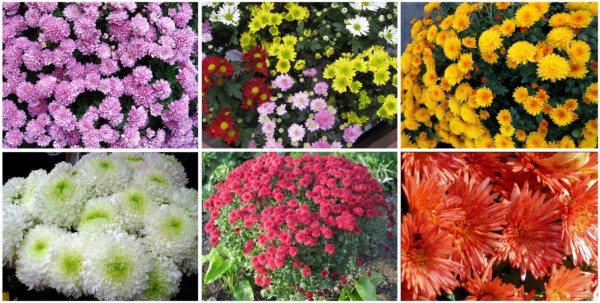

Chrysanthemum species
The wealth of modern varieties comes from just two species: the southeastern Indian and the Chinese mulberry. Some chrysanthemums are cut only in greenhouses, others outdoors or even in pots.
Gazelle
An early large-flowered variety begins to bloom in late summer, grows up to 60 cm and is used for bouquets. Smooth shoots with small light green leaves are adorned with large double white flowers that can grow up to 16 cm in diameter.
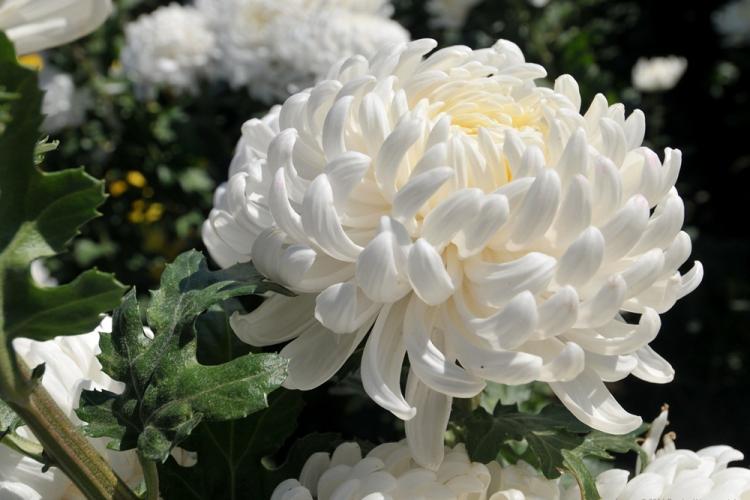

Alyonushka
A graceful tall shrub with small pink flowers up to 35 cm in diameter. The variety belongs to the early and begins to bloom in September, and the diameter of the blossoming buds is up to 6-7 cm. The dense dark green foliage creates a bright juicy background during flowering.
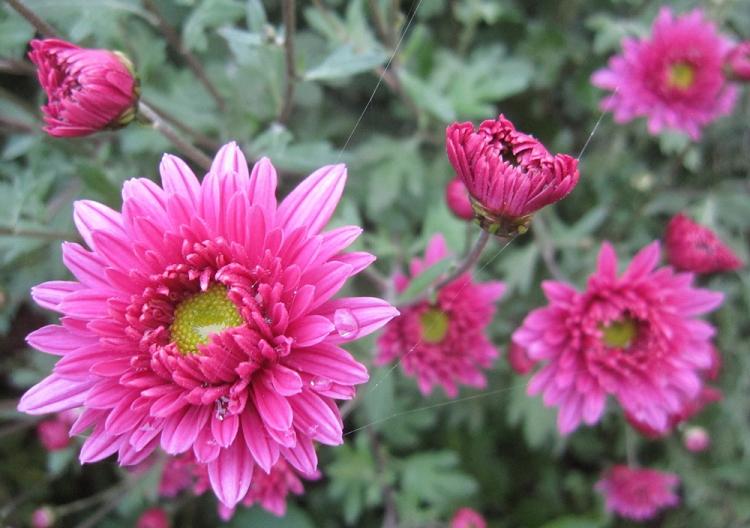

Evelyn Bush
This is a classic white chrysanthemum native to England with powerful stems densely covered with dark leaves. The bushes reach a height of 1.5 m and need a support so that dense dense double flowers do not outweigh. Spherical inflorescences easily reach 15 cm, and gradually turn yellow towards the middle. Evelyn Bush is a variety with increased resistance to disease and frost, just warm the rhizome for winter.
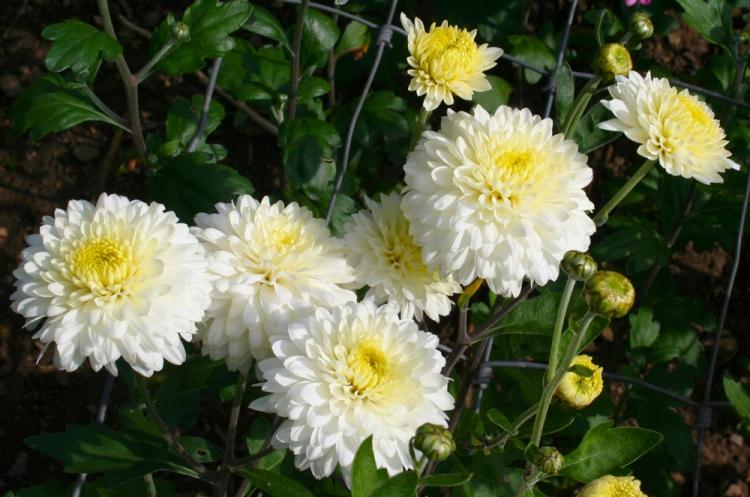

Valentina Tereshkova
An elegant decorative variety of large-flowered chrysanthemums of a delicate pink shade was bred in the Crimea. Unlike Gazelle, Valentina Tereshkova has large expressive leaves. The color of the flowers is not uniform: it is darker in the middle, and brightens towards the lower edges.
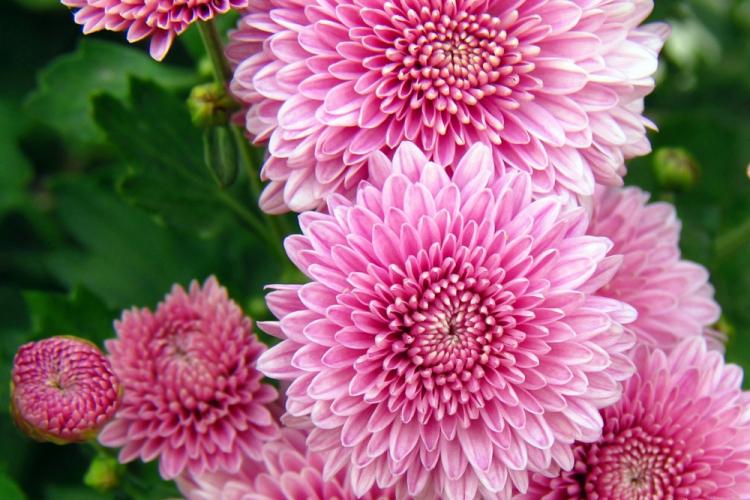

Ida
The graceful spherical bush grows up to 60 cm and is covered with small flowers up to 3 cm in diameter.It is a perennial variety of chrysanthemums that begins to bloom by the end of September or early October.
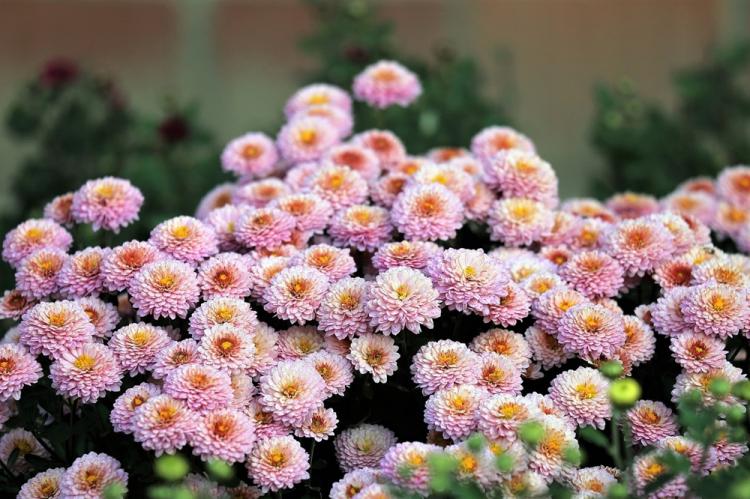

Flammenstahl
The popular annual variety is planted with seedlings every spring and belongs to keeled chrysanthemums. The flowers resemble chamomile, only in a bright fiery or purple hue with a yellow border and a golden core. In bouquets, Flammenstahl is in perfect harmony with the same colored keeled chrysanthemums.
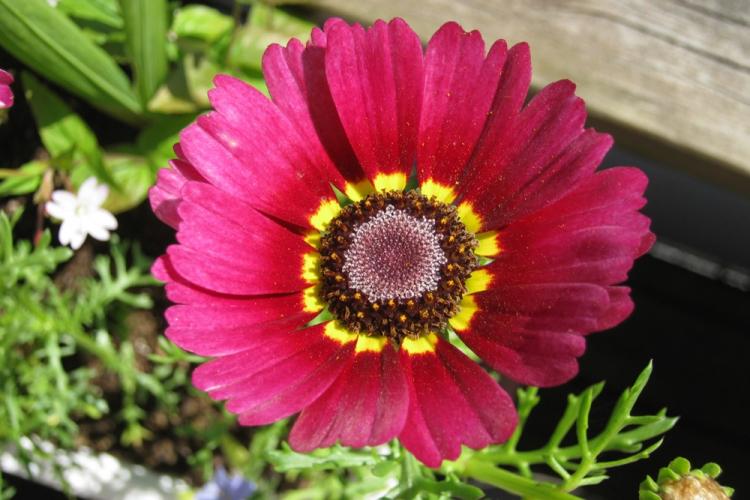

Cockard
Cockard is a bright and expressive variety, the peculiarity of which is its long three-month flowering, which begins in July. Simple non-double flowers are more like buds with snow-white petals, a bright ocher center and contrasting red-brown rings.
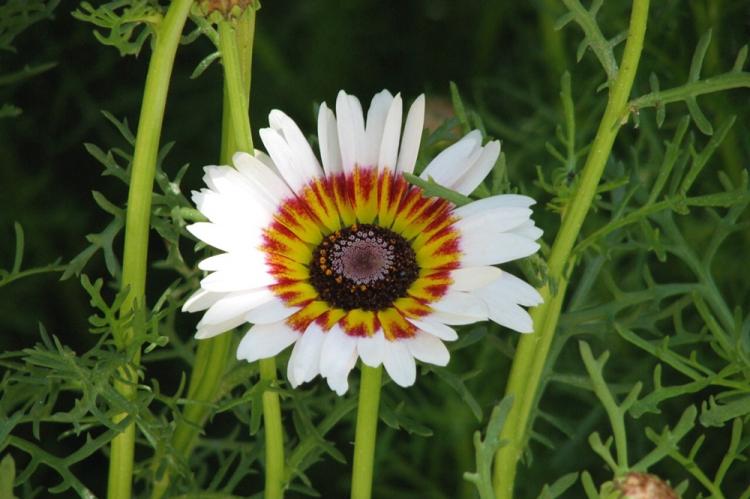

Multiflora
The main feature of this variety is a huge and varied range of colors: from white and pink to yellow, orange, red and even almost purple. A perennial species with abundant small flowering on spherical bushes blooms in all its glory by September.
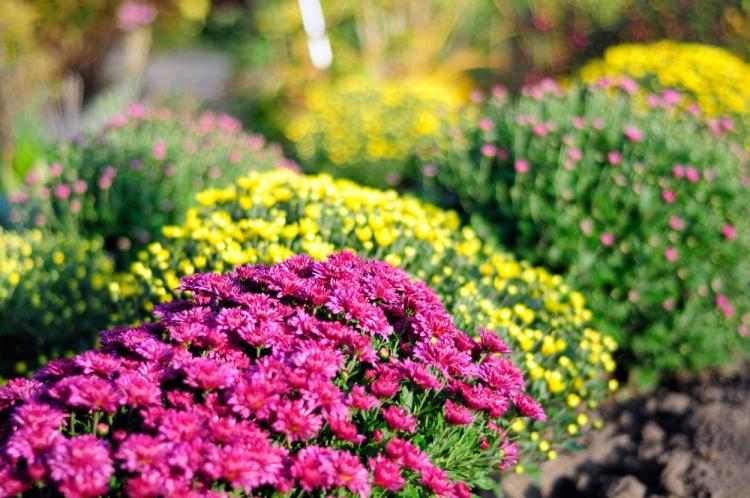

Sowing chrysanthemum
This small perennial variety is also called field variety, and outwardly it is most similar to large daisies. White, yellow or grayish petals grow around a flat core with a diameter of 3-5 cm. The height of the bush is 30-60 cm, and all of it is dotted with feathery or serrated textured leaves.
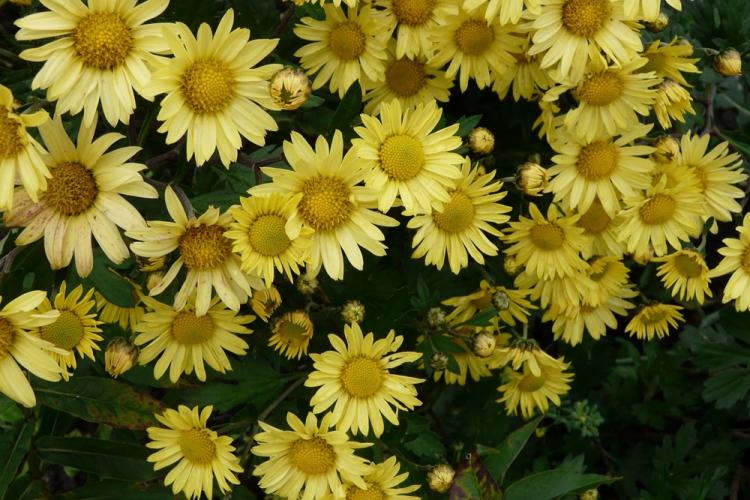

Zembla
The decorative medium-flowered variety is actively used for bouquets due to its neat, even shoots. The stem is densely covered with leaves - dark green, fancy cut shape. The flowers are also lush, in the form of graceful and elegant hemispheres of yellow, orange or pink with a greenish core.
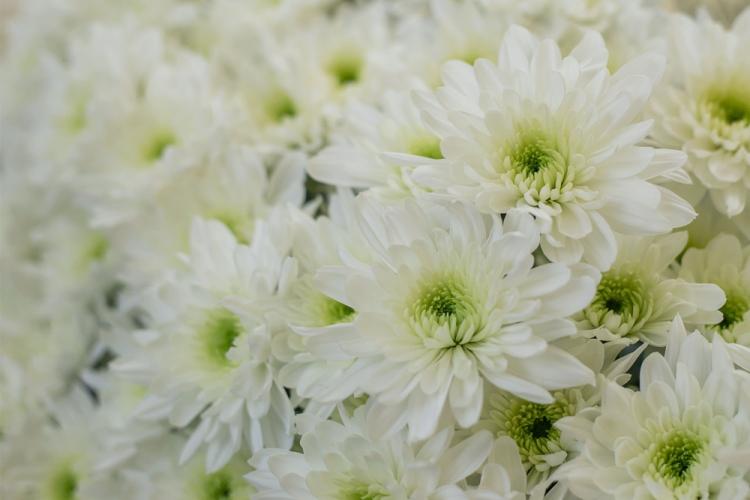

Shamrock
The lush, single-headed chrysanthemum is notable for its voluminous spherical flower, the petals of which are turned upward and tightly cover the entire core. The diameter of the ball reaches 10-12 cm, and an unusual green shade is combined with the same unusual pronounced aroma. The height of the flower is up to 80 cm, and in a bouquet it can stand up to 20 days.
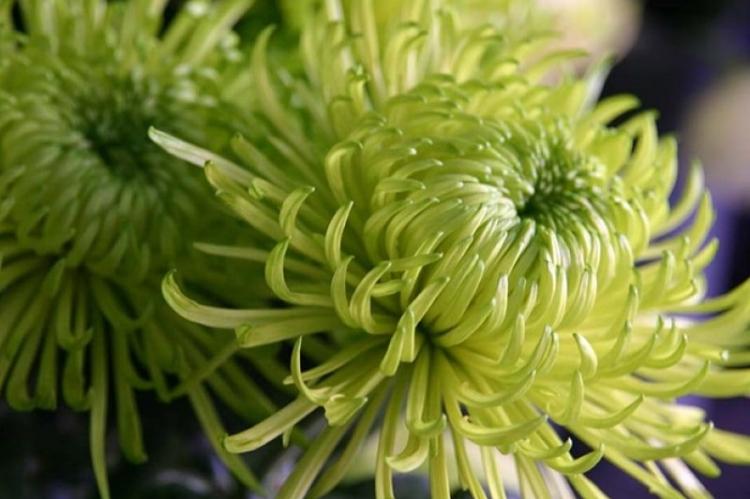

Planting a plant
Planting perennial chrysanthemums should be carried out correctly, so that later you can provide correct care for it and admire the beauty of flowering. Keep in mind that only flowers that are resistant to severe frosts, typical of winter time, are planted on the personal plot: zoned varieties and chrysanthemums grown from seeds. It is advisable to plant the rest of the varieties in pots with children or seeds. They can be used to decorate the house.
When to plant chrysanthemums outdoors? This is a topical issue. Flowers can often be found in stores in the fall, but planting is best in the spring. The wintering of a newly purchased plant must be carried out in pots, otherwise it may simply not withstand the winter, because all efforts will be spent on rooting the flower in the ground. In the southern part of the country, the flower is planted in late April or early May, and in the northern parts - after spring frosts.
First, you should correctly choose a place for planting a flower. A prerequisite is excellent illumination, and it is also worth taking care of a sufficient amount of sunlight during the day. Chrysanthemums do not bloom well in the shade: the flowers will become small, and the stems will be very tall, as they will stretch high in search of sunlight. It is good when there is protection from the wind, as well as sufficient moisture in the soil (the soil should not be dry all the time, but stagnation of liquid after sowing chrysanthemums should be avoided).
Separately consider the following soil requirements for planted plants:
- it must allow both air and moisture to pass through;
- the correct soil is loose;
- you can use soil of any type and composition, with the exception of heavy clay;
- it is desirable that the flowers be planted in fertile soil (on a poor flowering will be weak);
- choose a slightly acidic soil (add peat to the holes during planting and subsequent care of chrysanthemums).
How to plant chrysanthemums correctly? The algorithm is simple and involves the following steps:
- First you need to prepare the holes, the depth of which should be about 40 centimeters. 40 centimeters are left between the pits, and 50 centimeters between the rows.
- At the bottom of each pit, a drainage layer, for example, of sand or stones, must be laid.
- Pour one handful of humus into each hole and water the soil well.
- Plant your chrysanthemums so as not to deepen them too much.
- Install stakes nearby, which will become a support for the bushes. If necessary (or immediately, if the chrysanthemum is tall), you need to tie a flower.
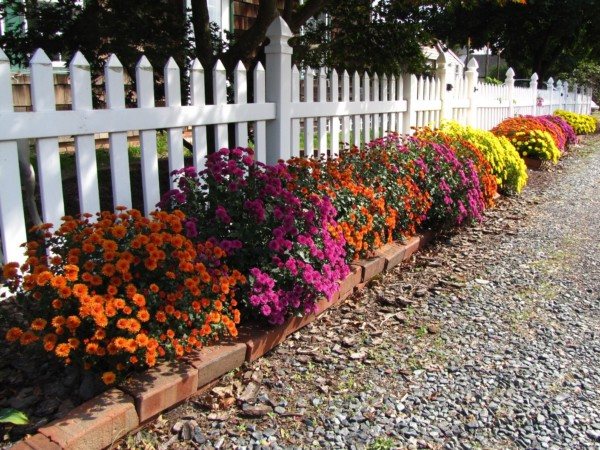

After planting, you should figure out what the proper care of the plant should be so that it pleases with flowering. First you need to pinch the top for better tillering. This is done after the plant has rooted. After three weeks, the pinching procedure is repeated, achieving a spherical shape of the bush. But keep in mind that if the bushes are planted at the beginning of summer, then it is too late to pinch. Leave the single-barreled crop, which also looks interesting.
Diseases and pests
Seed-grown chrysanthemum multiflora and other popular flower varieties are susceptible to several diseases and insect pests. Flowers can infect slugs, aphids, spider mites, powdery mildew, mold, black spot. To solve these problems, both folk remedies and substances purchased in specialized stores are used. It is important to fully understand the symptoms of the disease or how to eliminate the pests in order to quickly get rid of the problems that have arisen. Chrysanthemum seeds are often sold already treated for certain diseases.
How to properly care for horticultural crops?
Care for a crop such as perennial garden chrysanthemum, like planting, is available for any gardener. It is imperative to take care of correct and timely watering, because these plants are very sensitive to insufficient moisture. This will be evidenced by the formation of rare and small flowers, as well as stiffening of the stem. But excess water should also be avoided, as the root system may begin to rot. Stick to the middle ground (the soil under the bush should be slightly damp all the time), and pay attention to the weather (watering should be more frequent in hot weather and infrequent in cold weather).
Varieties and varieties of chrysanthemums
Conventionally, all chrysanthemums can be divided into 2 types:
- Large-flowered (Indian) - depending on the variety, the diameter of the inflorescences can be about 10-25 centimeters;
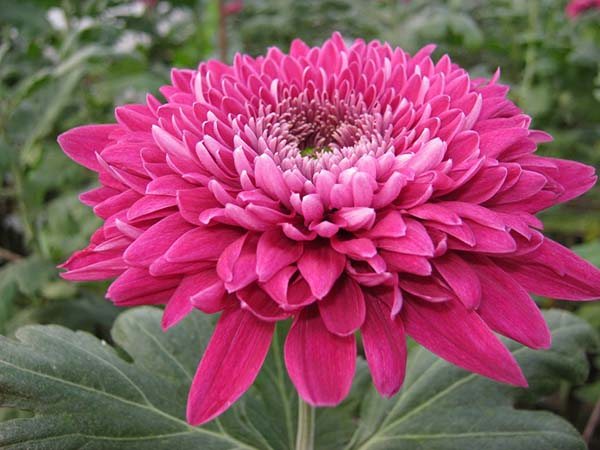

- Small-flowered (Korean) - the diameter of the inflorescences is from 2 to 9 centimeters.
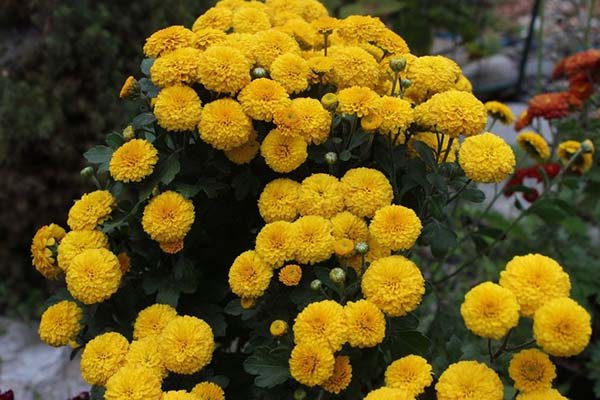

As a rule, perennial Korean varieties that winter well (but better with additional shelter) are planted and grown in our gardens. And the most popular are spherical garden chrysanthemums (multiflora).
Large-flowered varieties are most commonly used for commercial purposes, i.e. for cutting and making bouquets, because they need warmer conditions, clearly not in the middle zone or the Urals and Siberia, where they simply freeze out.
Video: types and varieties of chrysanthemums
Chrysanthemum buds have dried up. The reasons
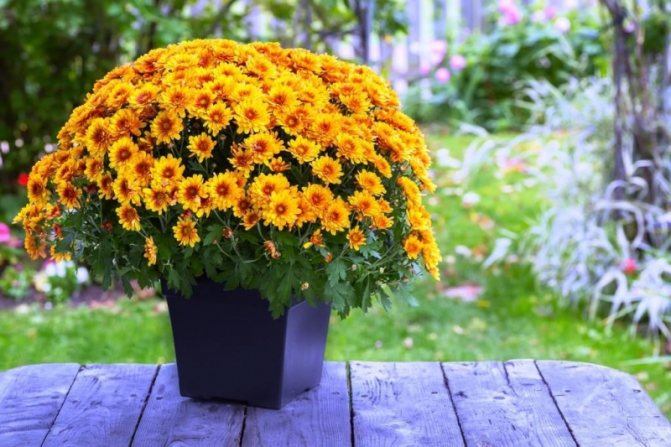

After the first flowering, some buds may remain unopened, after which they slowly begin to dry. Fertilizers will not help, because the cause can be an overdose of top dressing, which is considered a common problem among newcomers to gardening. You should not only adhere to the indicated recommendations from the manufacturer regarding dosages, but also observe the frequency of application.
Among the reasons, the lack of regular watering should be noted. Dry soil will not allow young and fragile buds to bloom.
Among the reasons, the presence of pests is also distinguished. Kidney mites, saricides and weevils love to feast on the delicate pedicel, which leads to the drying out of the latter.The last two species are problematic to detect, since they hide during daylight hours, and to detect it, you need a magnifying glass, which is directed to the broken bud.
To combat reptiles, remove all affected buds and treat the plant with a solution called an insecticide. Manipulations are carried out three times a day for a week. With a lack of watering, the flowers can be attacked by ticks. To eliminate weevils and saricides, insecticide injections are used twice with an interval of two weeks. Parasites feast on rotten remains and live in waterlogged soil and other places where moisture regularly accumulates. Such conditions are also suitable for ants, fools and cockroaches.
Breeding methods for chrysanthemums
Basically, garden chrysanthemums are propagated by dividing the bush or by cuttings, in other words, by vegetative methods. But often it is also grown from seeds.
By the way! Large-flowered and small-flowered (Korean) species reproduce identically.
Sowing seeds
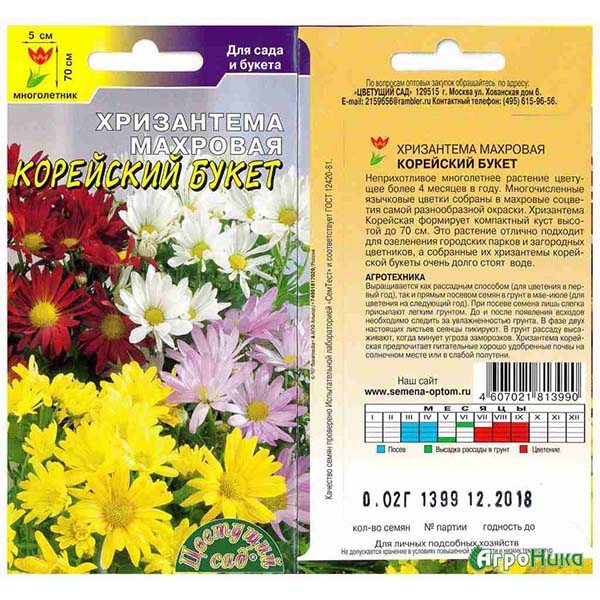

Perennial chrysanthemums can be sown with seeds, but varietal characteristics will not be preserved when collecting planting material and re-sowing it. If you nevertheless decide to buy seeds, then it is better to first sow them for seedlings (in February-March), dive in the phase of two true leaves, and when the threat of return frosts has passed, plant them in the ground (or a pot). And then by the fall you will be able to get flowering bushes. Alternatively, you can try open field direct sowing in May-June.
Dividing the bush
Once every 2-3 years, the root system of the garden chrysanthemum grows excessively, begins to degenerate, the flowers become smaller, so the plant should be rejuvenated, that is, divided.
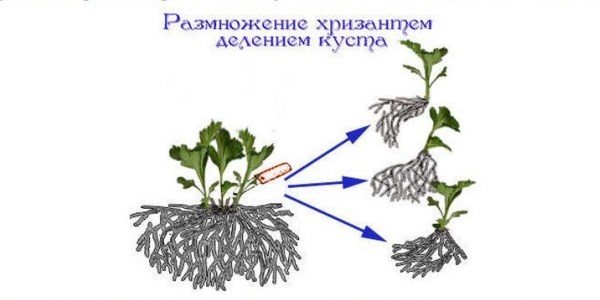

Dividing the plant is quite simple: you need to carefully dig up the bushes and divide them into several copies (with your hands, pruning shears or even a shovel). Then place them in separate holes and shade them with a non-woven material from the sun (stick 4 sticks and throw a cover on them) so that they do not get burned while they are being taken.
Video: transplanting chrysanthemums by dividing the bush
Cuttings
It is convenient to cut chrysanthemums during autumn pruning. To do this, you will need to cut, or better break off, 5-8 centimeter shoots (the flowers themselves must be cut off, and only a couple of leaves should be left), which can be rooted either in a glass of water or in a common container in a special substrate (from peat and sand or in a mixture of perlite with the same peat) and cover with a plastic bag to create a greenhouse effect.


When the plant has roots (after 2-3 weeks), they should be planted in separate containers. In winter, young seedlings should be kept in a cool place (+4 .. + 6 degrees) and do not forget to water if necessary. When planting cuttings in spring, it is advisable to shade them for the first time (2 weeks), for example, by making a canopy of spunbond.
Video: cuttings of chrysanthemums in the fall
Video: cuttings in spring
Advice! You can also cut chrysanthemums from the presented bouquet.
Video: how to root chrysanthemums from a bouquet - cuttings and the result
What chrysanthemum seeds look like
The seeds of this flower are rather small (5-7 mm in length). They are brown, grayish or light brown in color. A large handful fits in the palm of your hand. When working, it is most convenient to take them with dry fingers.
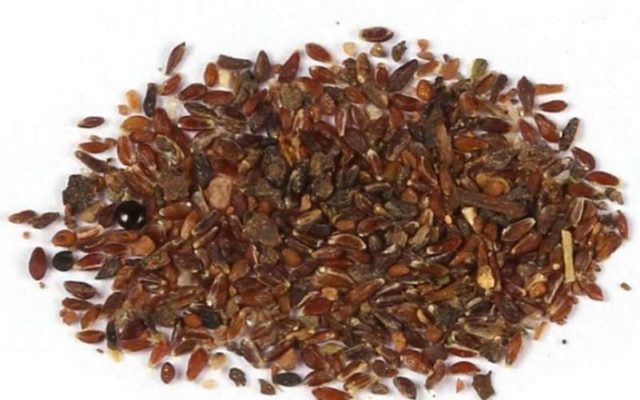

The seeds are small, so you need to work with them carefully.
Chrysanthemum seed can be purchased at any store or collected by yourself. In doing so, it is important to consider a few practical points:
- large-flowered and double varieties of seeds have very few seeds, besides, it is difficult to grow seedlings, it is much easier to propagate by cuttings or other vegetative methods;
- small-flowered and semi-double varieties, on the contrary, have a lot of seeds, it is easy to grow seedlings;
- it is recommended to collect seed from varieties that are early or mid-early.
Planting dates for chrysanthemums
Depending on the method of reproduction, the timing differs when it is better to sow, transplant (divide) or cut chrysanthemums.
So, sow seeds chrysanthemums for seedlings optimally in early spring (even in February-March), or in open ground in May, when the ground warms up enough (but then flowering should be expected only next year).
Cut chrysanthemum bushes most convenient in autumn during regular pruning, but keeping them in winter is difficult enough, and they often die, therefore it is better do it all the same in the spring, survival rate in this case is much higher.
Dividing the bush and the transplant of chrysanthemums can be done both in the second half of spring, when the threat of age-related frosts passes (in April-May), and in late summer - early autumn (in August-September), so that the bushes have time to take root in a new place before the cold snap.
How to store potted chrysanthemums in winter. Storage methods
To preserve chrysanthemum cuttings in winter, you can use several methods: for example, leave them in the open field, dig them up and plant in pots or in a cellar, place them in a greenhouse or even on a balcony.
It is also important to ensure that the room temperature does not drop below +10 degrees Celsius.
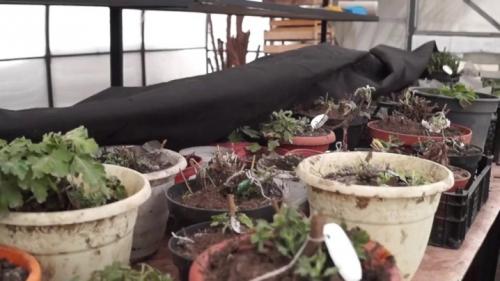

In a flowerpot
Many gardeners keep small plants in pots by placing them in heated rooms. First you need to carefully dig up the flowering bush. In order not to damage the roots in the process, the ground around the bush must first be watered well, wait a little, and only then start digging. In the meantime, you need to start preparing the flowerpot.
It is better to take a wide and not too high pot, because the roots of the chrysanthemum are quite massive.
A drainage layer must be laid at the very bottom. You can use either fine gravel or broken brick. Then you need to place the chrysanthemum in a pot, and very carefully sprinkle everything with a loose substrate.
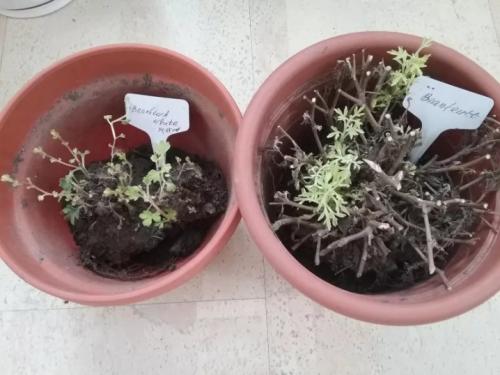

During flowering, the pot can be placed on or near a well-lit windowsill. When the chrysanthemum has completely bloomed, you can start pruning it. After that, the flowerpots must be placed in a cool place, for example, in the basement, and stored there until spring. If young shoots appear during this period, they must be broken off immediately. In this case, the flowers will be very lush in summer. When the frosts have completely receded, the chrysanthemums can be planted in a new place.
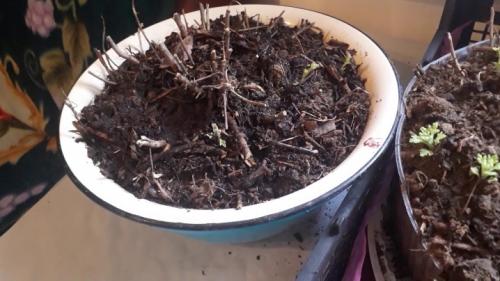

In the greenhouse
In order to prolong the flowering of chrysanthemums, they must be transplanted into the greenhouse in advance. With the onset of the first frost, all the stems will need to be removed, leaving only 2 centimeters of the plant above the ground. After that, the wintering bushes must be sprinkled with a layer of dry humus. Its height should not be less than 25 centimeters. In addition, you will need to cover the chrysanthemums with any covering material.
With the onset of spring, you need to take care of the timely opening of the bushes.
If this is not done, then they will simply vytryut, that is, they will die. In the event that the greenhouse is heated, and the temperature inside it is within 5 degrees above zero, the plants will not need shelter.
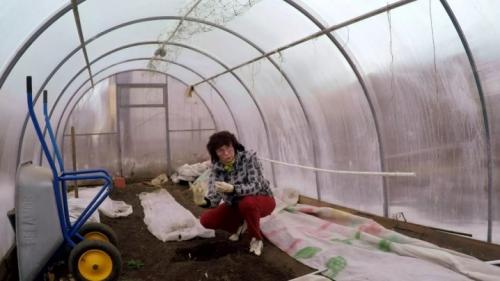

In a container
Very often, buckets, boxes or any other container are used to preserve chrysanthemums in the winter. Peat and coarse sand must be poured into the container in equal parts. To store flowers, you can use warm basements or cellars, warm balconies or even sheds. The temperature in such rooms should not rise above +5 degrees and drop below +1 degrees Celsius.
It is very important that the indoor climate is always stable.
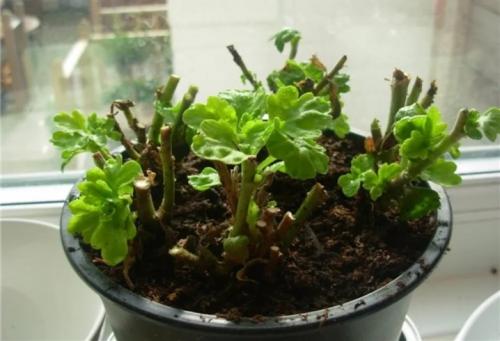

In the cellar on the floor
The success of this option depends not only on the level of preparation of the plant, but also on how suitable the cellar is, in which the chrysanthemum will winter. First of all, the room temperature should be within 3-5 degrees above zero. In addition, the cellar must be well ventilated. It should be free of any traces of mold and any insects.
For storage in the cellar, the plant must be dug up in late autumn.
This procedure must be carried out quite carefully, without shaking off the ground from the roots. Then the dug out chrysanthemums need to be left in the fresh air for several days so that they can dry well. If suddenly the plant was infected, it must be sprayed using special insecticides.
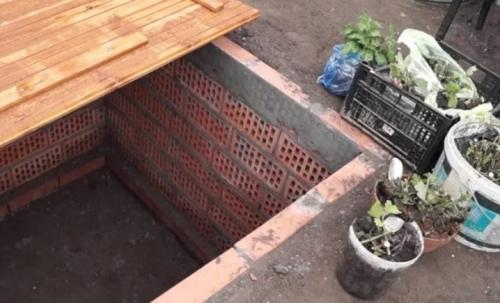

Next, chrysanthemums must be moved to the basement, where they can be stored directly on the floor or in a specially prepared box. Plants must be laid very tightly to each other, and covered with a layer of earth on top. In the event that it is very warm in the cellar, the chrysanthemum can sprout even in the middle of winter. However, they will be very weak at this time, so it will be better to get rid of them.
Chrysanthemums stored in the cellar do not require special care. It will be enough to examine them once a month.
When the roots are too dry and lethargic, they should be sprayed with water. If mold or mildew appears on the chrysanthemums, they must be removed from the cellar immediately. Those plants that are not infected are best treated with special anti-fungal drugs.
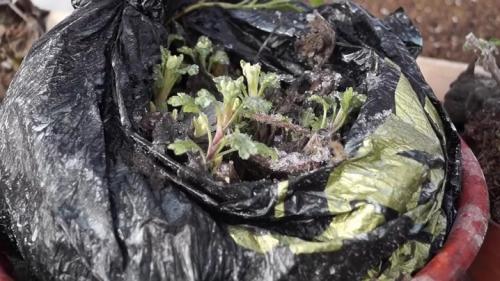

In the trench
You can also store chrysanthemums in the prikop in winter. However, this is possible only in those regions where the ground does not freeze very deeply. In addition, the snow cover should be quite large. But in the spring, it is imperative to free the trench from snow so that it is dry. The depth of the trench should be between 50 centimeters and one meter.
Gardeners recommend making it narrow: this way the flowers will be able to survive much better.
Chrysanthemums need to be dug up and laid on the very bottom very tightly to each other. In the event that there are too many plants, they can even be laid in two layers. Sprinkle them on top with either dry sawdust or dry leaves. Then everything needs to be covered with spruce branches. In addition, you can add another layer of covering material. For this, boards or slate are suitable. From above, you can additionally cover them with foil. In the spring, the covering material will need to be removed, but it is best to do this gradually.
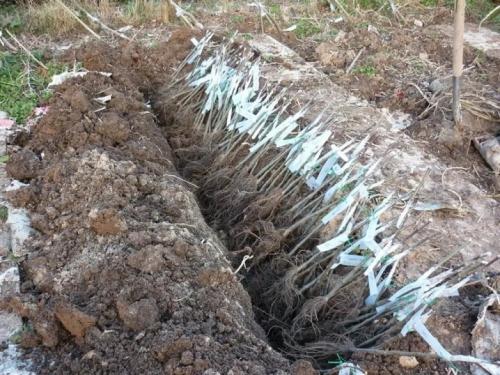

How to plant chrysanthemums outdoors
In order to eliminate all problems with the growth and development of perennial garden chrysanthemums in the open field, you need to remember about choosing a suitable place, as well as soil for planting.
Landing place
To successfully grow chrysanthemums in the garden, it is very important to stay in the right place to plant. If possible, this should be the sunniest area in the country. The plant does not like constant drafts, but it does not like stagnant air either, so the place should be ventilated. It is optimal to choose more or less elevated areas, hills, slopes, since it is impossible to allow the root system to be constantly flooded with water.
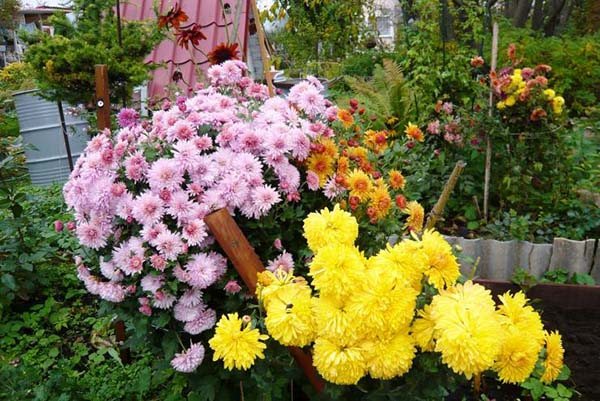

Garden perennial chrysanthemum is ideal for creating living borders, that is, for decorating garden paths, as well as creating beautiful compositions around the house.
Wintering
Large-flowered chrysanthemums are thermophilic plants. And they won't survive the winter outdoors, even under good cover. Therefore, with the onset of cold weather, dig up the mother bushes, cut off all the shoots at a height of 10-15 cm, place them in a wooden box along with an earthen lump. Store flowers in a cellar at 0 ... + 4 ° C and 80% humidity.
Water the soil occasionally to keep it slightly damp. Inspect the bushes regularly, and if you notice signs of mold, then immediately cut out the damaged branches, otherwise the whole flower will die.
In late February or early March, move the bushes to a warmer and brighter room. Provide them with regular watering. And when they "come to life" and start growing, you can carry out cuttings of flowers.
If you have no desire to propagate crops, then simply plant the mother bush in its usual place as soon as the weather is warm. But keep in mind that every three years you need to change the area for the flower garden.Otherwise, the plants will start to be capricious and hurt, which will affect their decorative effect not for the better.
Outdoor chrysanthemum care
Chrysanthemum can hardly be called an unpretentious plant, on the contrary, it requires constant care. Therefore, in order to get beautiful bushes, these perennial flowers must be watered, fed, shaped (cut and cut), transplanted and propagated (divided and cut) and covered for the winter.
Important! And tall, as a rule, large-flowered (but small-flowered chrysanthemums are also tall) chrysanthemums must also be tied to pegs so that they do not lie down or, even worse, do not break off.
Watering
The plant can be called moisture-loving, but it should not be waterlogged (in spring, natural moisture, as a rule, will be enough for it).
Advice! After planting (planting a rooted cuttings) or transplanting (dividing) chrysanthemums in the spring, young seedlings should be periodically watered moderately.
At the height of summer (June-July), a garden perennial requires abundant watering, since the process of bud formation occurs during this period. As soon as flowering begins (usually in August), watering should be reduced. With a lack of moisture, the stems of the plant will become woody and stop branching.
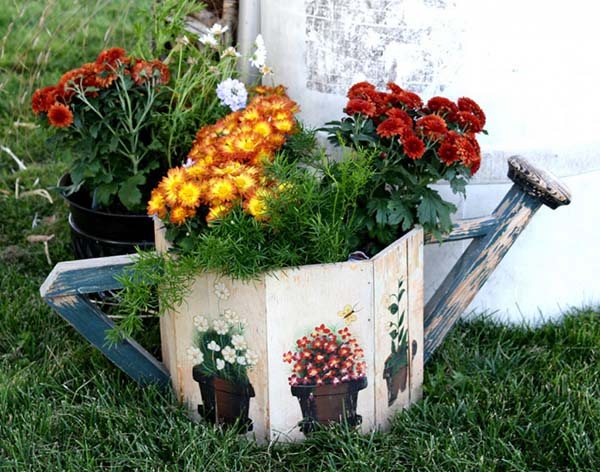

Important! Chrysanthemums must be watered exclusively at the root. Sprinkling the crown is prohibited. Of course, if possible, it is advisable to use rainwater or settled water, and loosen it after each watering so that a dry crust does not form.
Top dressing
Chrysanthemums are fed according to the standard scheme:
- In early spring, nitrogen fertilizers are used to start the growth of green mass (for example, an infusion of mullein in a ratio of 1 to 10 or chicken droppings (1 to 15).
- In summer, during budding with potassium-phosphorus (more potassium) fertilizers - for a more intense and lush flowering (for example, wood ash).
- In autumn - phosphorus-potassium (more phosphorus). Phosphorus has a good effect on strengthening the root system, which is necessary during the preparation of the plant for wintering.
There are special complex fertilizers for chrysanthemums for the entire growing season.
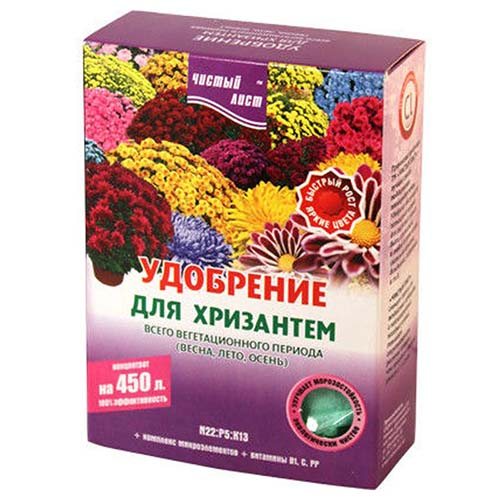

And if you still grow roses, then this fertilizer will be useful to you.
Note! Top dressing must be carried out exclusively after watering and only at the root, in no case falling on the leaves, otherwise the fertilizer can cause them burns.
Shaping, cutting and trimming
If you want to get spherical bushes of chrysanthemums, then they should do such a haircut in the spring. It is recommended to pinch the top (main shoot) every year after 5-6 leaves, when it reaches 10-12 centimeters. Likewise, the side shoots should be shortened. All these activities should be performed before budding begins.
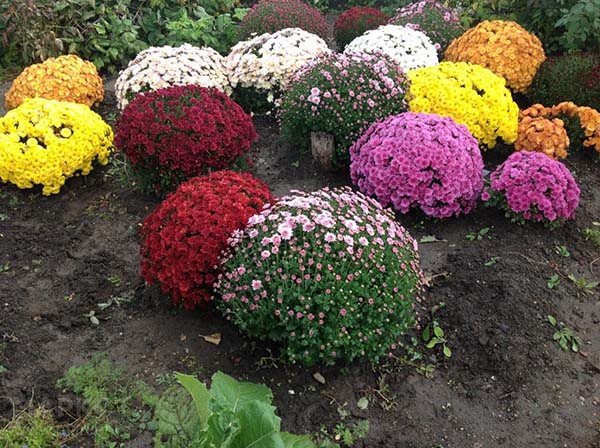

By the way! Chrysanthemum multiflora grows independently in the form of a ball. It should only be pinched once, when 2 pairs of leaves appear on the shoots, then it will form itself.
If you are growing large-flowered chrysanthemums for cutting (for bouquets), then you should leave 2-3 stems on which large buds and inflorescences will appear. It is also important not to forget to pinch them, timely removing the shoots that appear from the leaf axils.
For the winter, in the small-flowered (Korean) variety, of course, the entire upper part is cut off and a small stump is left (about 10 centimeters).
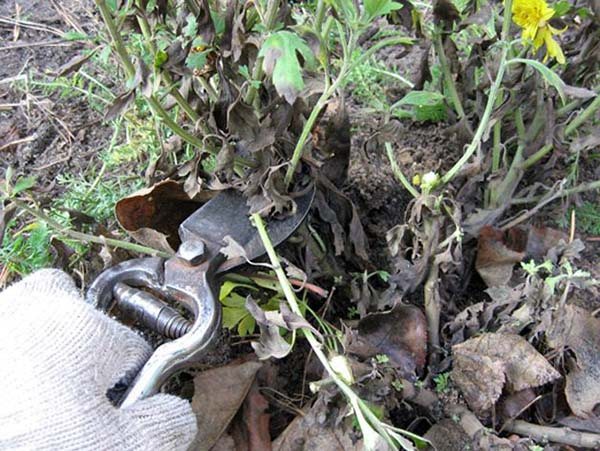

Preparing for winter
Some growers are afraid that even their small-flowered chrysanthemum can freeze out in winter, therefore, in mid-autumn (October), the trunk circle should be covered with a thick 10 cm layer of peat or compost, and already at the end of autumn (November), cover the plant, for example, with spunbond or dry leaves, you can use hay, or even better spruce branches.
Note! There is no point in insulating and covering large-flowered chrysanthemums, since they do not hibernate in the open field. They need to be dug up and transferred to storage prior to spring disembarkation.
At the same time, Korean specimens can also simply be transplanted into pots and transferred to the basement or veranda for wintering, or you can also dig in a polycarbonate greenhouse at soil level and additionally cover.
By the way! Read in detail about the autumn care of chrysanthemums, their preparation for winter (shelter and digging-storage) in this article.
Video: how to keep chrysanthemums in winter: the right shelter
Diseases and pests
One of the most common troubles that occurs with a chrysanthemum is the first appearance white bloom, and then altogether blackening and dying off of its leaves. All this indicates a disease of a garden perennial. powdery mildew... Frequent rains and, as a result, waterlogging, thickened plantings, temperature fluctuations are the most favorable environment for the development of this disease. To restore the plant to its former beauty, it should be sprayed a couple of times with preparations containing copper in its base (for example, copper sulfate or Bordeaux liquid).
Often attacks chrysanthemums aphids and thrips, in this case, you will need to treat garden perennials with one of the special insecticidal preparations, for example, "Aktara" or "Fitoverm".
Video: spherical chrysanthemums - planting, care and shelter
If you are nevertheless imbued with the idea of planting and growing a bush garden perennial chrysanthemum in your summer cottage, focus on the features of care and its reproduction. And then you can amaze all your neighbors with the splendor of an autumn flower.
Video: features of the care and reproduction of bush chrysanthemums
Chrysanthemum multiflora wintering experience
Chrysanthemum bushes multiflora after flowering should be cut off, while it is desirable to leave a "stump" 8-10 cm in size. Sometimes young sprouts of chrysanthemums are formed not below, but on these "stumps".
If there is still no severe frost (up to -7 ... -10 degrees), then let the mother liquors stand outside or in an unheated greenhouse. Plants can be kept in the greenhouse for longer.
At night, you can cover the chrysanthemum bushes with dense covering material. It is possible to use for this purpose any old blanket or coat - whoever has that at hand.
Do not rush to bring the queen cells of chrysanthemums into the storage, because there will be a positive and constant temperature. This means that in such conditions, chrysanthemums will begin to grow; and we need them to sleep.
Many sources report that for the wintering of multiflora chrysanthemums, a low positive temperature (+ 2 ... + 5 degrees Celsius) is needed. However, from my own experience, I can say that multiflora can withstand sub-zero temperatures with complete freezing of the earthy coma. For example, the winter of 2012-2013. our mother plants of chrysanthemums were in a barn (due to circumstances beyond our control), where the temperature dropped to -10 ... -12 degrees. We can say that our chrysanthemums withstood this cold test with dignity. All queen cells, which were planted in buckets in August, overwintered without lunges. And where the transplant was later (end of September), then there was a fall of chrysanthemums of about 10-15 percent.


